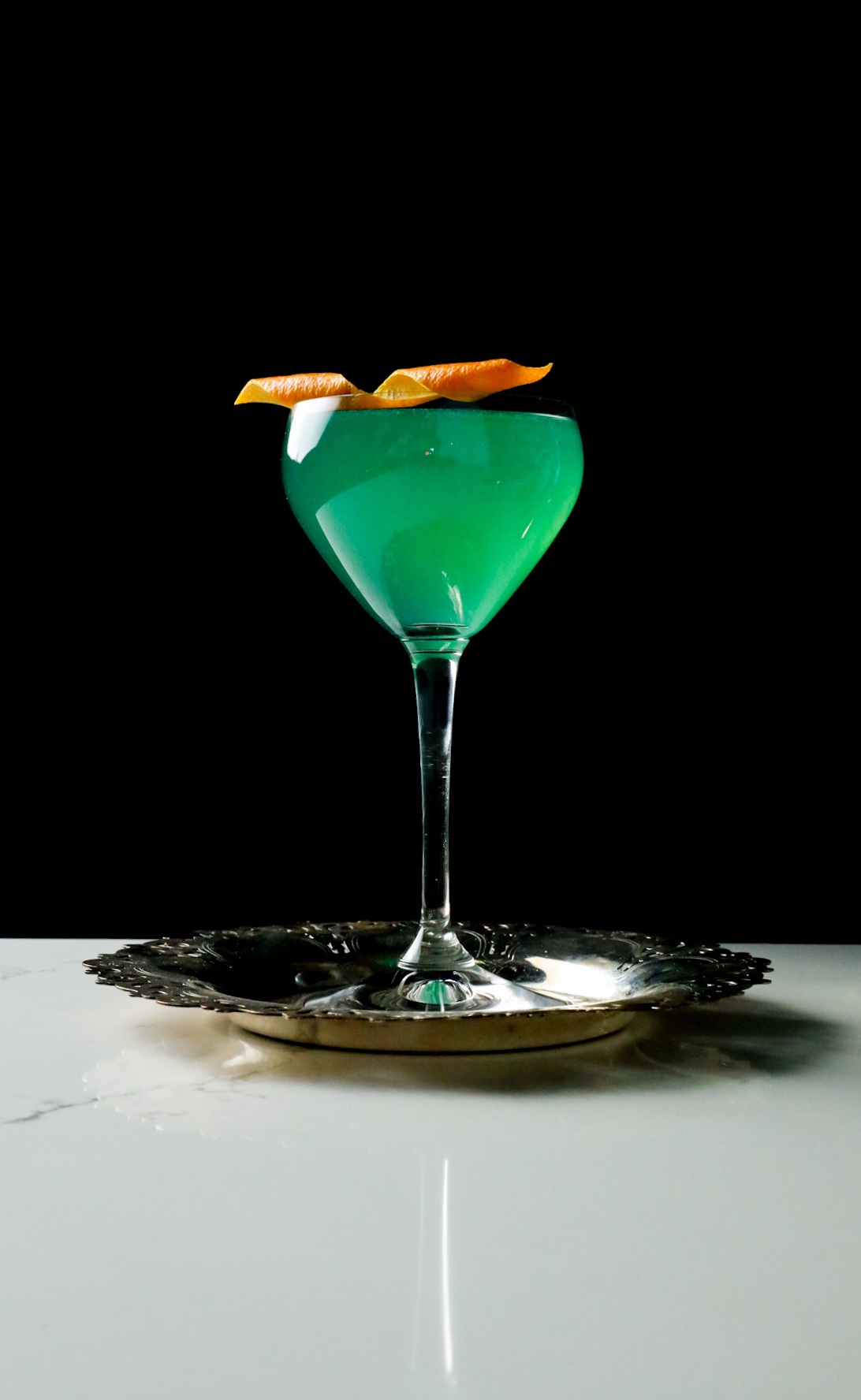
If you’ve been here for awhile, you’ll know that I’m a classy broad. I don’t go in for trends or gimmicks. I’m here for timeless silhouettes, flavours, and decor choices that transcend pop culture. As a result, this is the first cocktail using blue curaçao that you’ll find on the blog. Blue curaçao is a bit like blue Gatorade, the colour doesn’t match the flavour. Cool Blue Gatorade is actually raspberry flavour. Blue Curaçao is actually orange flavour.
Well, even that is dumbing it down a bit. Curaçao is actually traditionally made with the bitter peels of the otherwise unpalatable lahara fruit grown on the Dutch island of Curaçao. The lahara fruit was the offspring of the Seville orange which Spanish explorers had brought to the island.

While the true origin story of Curaçao liqueur is lost to time, the world’s oldest distilled spirits company, Bols, maintains that Lucas Bols developed a laraha-based liqueur in the 17th century after the discovery that an aromatic oil could be extracted from the unripe peel of the otherwise inedible bitter oranges. Bols then had this oil exported back to Amsterdam to produce a liqueur similar to current day Curaçao. Bols liked to add a dash of mystery to his spirits and in 1912 the company added blue colouring to the spirit and called it “Crème de Ciel” (“cream of the sky”) a reference to the 1907 musical Miss Hook of Holland – which you’ve undoubtedly seen.
You may be wondering how a distiller based in Amsterdam made it to the Caribbean island of Curaçao to determine that the oils from the peels of a useless bitter orange could be put to work in cocktails. I don’t have an answer for the latter portion of your curiosity, innovation and ingenuity are beautiful, unknowable things. For the former, Bols had shares in the Dutch West Indies Company which took possession of the island of Curaçao in 1634. Well, Bols, founded in 1575, owned shares in the company to guarantee its access to the spices and botanicals it required for distilling.

As the blue colouring is completely artificial and has no relationship to the lahara fruit used to make the liqueur, it’s very much a marketing tactic intended to capture the attention and imagination of potential buyers. Several have attempted to use butterfly pea extract to achieve the beautiful indigo hue naturally, but based on my reading, that experimentation hasn’t been entirely successful when it comes shelf-stability. That being said, there are a number of gins made using butterfly pea extract, like Empress 1908 Gin from Victoria, British Columbia.
Given the popularity of Empress today, I’m sure blue curaçao positively flew off the shelves in the early 20th century. It is the starring ingredient in many hangover-making cocktails like the Blue Lagoon and the Blue Hawaii. This Cerulean Seas cocktail however is a subtle variation on the “Lake at Night” cocktail from Shannon Mustipher’s brilliant book, “Tiki: Modern Tropical Cocktails” and is the epitome of sophistication, drawing on the blue curaçao for an arresting visual effect.

I’ve followed Shannon’s original recipe but increased the honey syrup to suit my palate and make for an even easier drinking concoction. I’ve also provided a hack if you don’t have the Lapsang Souchong tea to infuse the vodka with its signature campfire flavour. I used the Lapsang Souchong tea as a float in my Zero-Proof Penicillin recipe from January.
I’m a big fan of the combination of honey syrup with cardamom bitters and was all too happy to put it to work in this drink. This drink is a subtle take on a sour, using less “sour” and less “sweet” than you would typically find in the 2 parts spirit, 1 part sour, 1 part sweet formula employed for a sour like a gimlet.
While the blue curaçao lends a striking aesthetic, don’t be afraid to use another orange liqueur like orange curaçao, Cointreau or Triple Sec. After all, it’s about participation, not perfection.

Cerulean Seas Cocktail
- 2 oz Lapsang souchong infused vodka OR 1¾ oz vodka and ¼ oz Islay scotch
- ¼ oz blue Curaçao
- ½ oz honey syrup
- ½ oz lemon juice
- 3 dashes cardamom bitters
- Garnish: orange twist
- 1 tsp loose leaf Lapsang souchong tea
- 2 oz boiling water
- 1 cup vodka
- 1 cup honey
- 1 cup boiling water
-
Add all ingredients to a shaker and shake until well-chilled. Strain into a chilled Nick & Nora (or coupe) glass. Express the orange peel onto the surface of the drink, twist, and place on the edge of the glass.
-
Steep 1 tsp of loose leaf Lapsang souchong tea in two ounces of water for 3 minutes. Drain the water and transfer the wet leaves to a glass or nonprorous, nonreactive container and add 1 cup of vodka.
-
Steep the leaves in the vodka at room temperature for 7 minutes. Drain and discard the leaves. Strain into a clean jar. Store in a cool, dark place. The infused vodka will keep indefinitely.
-
Combine honey and boiling water in a heatproof glass jar. Stir until honey is dissolved. Cool to room temperature before using. Honey syrup will keep refrigerated in an airtight container for 2 weeks.
Recipe adapted from: Mustipher, Shannon. “Lake at Night.” p. 44. Tiki: Modern Tropical Cocktails. New York: Rizzoli, 2019.


The pictures are not showing up in your post. But the cocktail sounds awesome
Hi Linda Ann, they are showing up for me on Safari and Chrome. Maybe try a different internet browser?